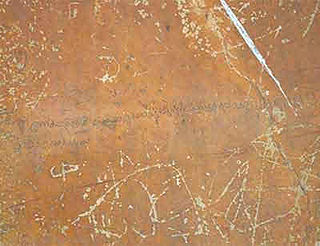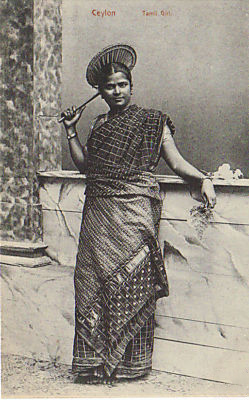Pāli, also known as Pali-Magadhi, is a classical Middle Indo-Aryan language on the Indian subcontinent. It is widely studied because it is the language of the Buddhist Pāli Canon or Tipiṭaka as well as the sacred language of Theravāda Buddhism. Pali was designated as a classical language by the Government of India on 3 October 2024.

The Sinhala script, also known as Sinhalese script, is a writing system used by the Sinhalese people and most Sri Lankans in Sri Lanka and elsewhere to write the Sinhala language as well as the liturgical languages Pali and Sanskrit. The Sinhalese Akṣara Mālāva, one of the Brahmic scripts, is a descendant of the Ancient Indian Brahmi script. It is also related to the Grantha script.
The "Sri Lanka Matha" is the national anthem of Sri Lanka. "Sri Lanka Matha" was composed by Ananda Samarakoon and was originally titled "Namo Namo Matha".
The Pāli Text Society is a text publication society founded in 1881 by Thomas William Rhys Davids "to foster and promote the study of Pāli texts." Pāli is the language in which the texts of the Theravada school of Buddhism are preserved. The Pāli texts are the oldest collection of Buddhist scriptures preserved in the language in which they were written down. The society first compiled, edited, and published Latin script versions of a large corpus of Pāli literature, including the Pāli Canon, as well as commentarial, exegetical texts, and histories. It publishes translations of many Pāli texts. It also publishes ancillary works including dictionaries, concordances, books for students of Pāli and the Journal of the Pali Text Society.

Sinhala, sometimes called Sinhalese, is an Indo-Aryan language primarily spoken by the Sinhalese people of Sri Lanka, who make up the largest ethnic group on the island, numbering about 16 million. Sinhala is also spoken as the first language by other ethnic groups in Sri Lanka, totalling about 2 million speakers as of 2001. It is written using the Sinhala script, which is a Brahmic script closely related to the Grantha script of South India.

The Tamil script is an abugida script that is used by Tamils and Tamil speakers in India, Sri Lanka, Malaysia, Singapore and elsewhere to write the Tamil language. It is one of the official scripts of the Indian Republic. Certain minority languages such as Saurashtra, Badaga, Irula and Paniya are also written in the Tamil script.

The Odia script is a Brahmic script used to write primarily Odia language and others including Sanskrit and other regional languages. It is one of the official scripts of the Indian Republic. The script has developed over more than 1000 years from a variant of Siddhaṃ script which was used in Eastern India, where the characteristic top line transformed into a distinct round umbrella shape due to the influence of palm leaf manuscripts and also being influenced by the neighbouring scripts from the Western and Southern regions.
Sri Lanka Indo-Portuguese, Ceylonese Portuguese Creole or Sri Lankan Portuguese Creole (SLPC) is a language spoken in Sri Lanka. While the predominant languages of the island are Sinhala and Tamil, the interaction of the Portuguese and the Sri Lankans led to the evolution of a new language, Sri Lanka Portuguese Creole (SLPC), which flourished as a lingua franca on the island for over 350 years (16th to mid-19th centuries). SLPC continues to be spoken by an unknown number of Sri Lankans, estimated to be extremely small.

Tigalari or Tulu script is a Southern Brahmic script which was used to write Tulu, Kannada, and Sanskrit languages. It was primarily used for writing Vedic texts in Sanskrit. It evolved from the Grantha script.
Sri Lanka, officially the Democratic Socialist Republic of Sri Lanka, is an island country in the northern Indian Ocean which has been known under various names over time.

Sri Lankan Tamils, also known as Ceylon Tamils or Eelam Tamils, are Tamils native to the South Asian island state of Sri Lanka. Today, they constitute a majority in the Northern Province, form the plurality in the Eastern Province and are in the minority throughout the rest of the country. 70% of Sri Lankan Tamils in Sri Lanka live in the Northern and Eastern provinces.

Corypha umbraculifera, the talipot palm, is a species of palm native to eastern and southern India and Sri Lanka. It is also grown in Cambodia, Myanmar, Thailand, Mauritius and the Andaman Islands. It is one of the five accepted species in the genus Corypha. It is a flowering plant with the largest inflorescence in the world. It lives up to 60 years before bearing flowers and fruits. It dies shortly after.

The banana leaf is the leaf of the banana plant, which may produce up to 40 leaves in a growing cycle. The leaves have a wide range of applications because they are large, flexible, waterproof and decorative. They are used for cooking, wrapping, and food-serving in a wide range of cuisines in tropical and subtropical areas. They are used for decorative and symbolic purposes in numerous Hindu and Buddhist ceremonies. In traditional home building in tropical areas, roofs and fences are made with dry banana-leaf thatch. Bananas and palm leaves were historically the primary writing surfaces in many nations of South and Southeast Asia.

The main languages spoken in Sri Lanka are Sinhala and Tamil. Several languages are spoken in Sri Lanka within the Indo-Aryan, Dravidian, and Austronesian families. Sri Lanka accords official status to Sinhala and Tamil, with English as a recognised language. The languages spoken on the island nation are deeply influenced by the various languages in India, Europe and Southeast Asia. Arab settlers and the colonial powers of Portugal, the Netherlands and Britain have also influenced the development of modern languages in Sri Lanka. See below for the most-spoken languages of Sri Lanka.

Neduntheevu or Nedunthivu is an island in the Palk Strait, northern Sri Lanka. This island is named as Delft in the Admiralty Chart unlike the other islands, whose names are Tamil. The island's area is 62 km and it is roughly oval-shaped. Its length is 11 km and its maximum width about 6 km.

Palm-leaf manuscripts are manuscripts made out of dried palm leaves. Palm leaves were used as writing materials in the Indian subcontinent and in Southeast Asia dating back to the 5th century BCE. Their use began in South Asia and spread to other regions, as texts on dried and smoke-treated palm leaves of the Palmyra or talipot palm. Their use continued until the 19th century when printing presses replaced hand-written manuscripts.
Sinhala numerals, are the units of the numeral system, originating from the Indian subcontinent, used in Sinhala language in modern-day Sri Lanka.
The National Museum Library is a division of the Department of National Museum in Sri Lanka functioning as its library and archive for its collection of books and documents. Established on 1 January 1877 as the Colombo National Museum Library when the Colombo National Museum was established, it incorporated the Government Oriental Library that had been established in 1870. Since 1885, by law, a copy of every document printed in the country is required to be lodged with the museum library as it functioned as the oldest legal deposit in Sri Lanka.
Pallikoodam or Ezhuthupally Pally is a word in Malayalam and Tamil that denotes a school. These were mostly village schools run by individual teachers and were distinct from Kalaris that taught martial arts.











